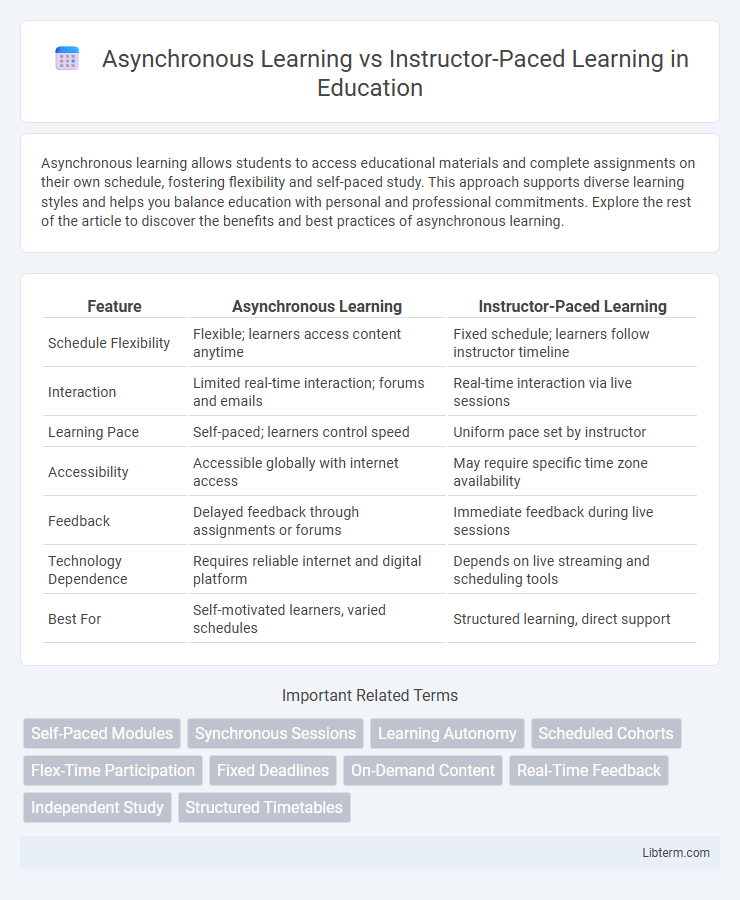Asynchronous learning allows students to access educational materials and complete assignments on their own schedule, fostering flexibility and self-paced study. This approach supports diverse learning styles and helps you balance education with personal and professional commitments. Explore the rest of the article to discover the benefits and best practices of asynchronous learning.
Table of Comparison
| Feature | Asynchronous Learning | Instructor-Paced Learning |
|---|---|---|
| Schedule Flexibility | Flexible; learners access content anytime | Fixed schedule; learners follow instructor timeline |
| Interaction | Limited real-time interaction; forums and emails | Real-time interaction via live sessions |
| Learning Pace | Self-paced; learners control speed | Uniform pace set by instructor |
| Accessibility | Accessible globally with internet access | May require specific time zone availability |
| Feedback | Delayed feedback through assignments or forums | Immediate feedback during live sessions |
| Technology Dependence | Requires reliable internet and digital platform | Depends on live streaming and scheduling tools |
| Best For | Self-motivated learners, varied schedules | Structured learning, direct support |
Introduction to Learning Modalities
Asynchronous learning allows students to access course materials and complete assignments on their own schedule, promoting flexibility and self-paced progress. Instructor-paced learning follows a structured timetable where the instructor controls the pace and sequence of content delivery, facilitating real-time interaction and immediate feedback. Understanding these learning modalities helps educators design effective instructional strategies tailored to diverse learner needs.
Defining Asynchronous Learning
Asynchronous learning refers to an educational method where students access course materials, such as lectures and assignments, at their own pace without real-time interaction with instructors or peers. This flexible approach allows learners to balance education with personal commitments, leveraging digital platforms like learning management systems for content delivery and assessment. Unlike instructor-paced learning, which follows a fixed schedule and synchronous sessions, asynchronous learning prioritizes autonomy and self-directed study.
Understanding Instructor-Paced Learning
Instructor-Paced Learning follows a structured schedule determined by the educator, ensuring all students progress through material simultaneously. This method facilitates real-time interaction, immediate feedback, and collaborative learning, which can enhance comprehension and retention. It typically involves live lectures, scheduled assignments, and group activities that align with a predetermined curriculum timeline.
Key Differences Between Asynchronous and Instructor-Paced Learning
Asynchronous learning allows students to access course materials and complete assignments at their own pace, often through online platforms, providing flexibility and self-directed study. Instructor-paced learning follows a structured schedule set by the teacher, with real-time lectures and deadlines that promote consistent progress and immediate feedback. The key difference lies in the timing and control over learning activities: asynchronous prioritizes learner autonomy, while instructor-paced emphasizes guided, synchronous interaction.
Flexibility and Accessibility Comparison
Asynchronous learning offers unmatched flexibility by allowing students to access course materials anytime and from any location, accommodating diverse schedules and learning paces. Instructor-paced learning provides a structured schedule with fixed class times, which can limit accessibility for learners balancing work, family, or time zone differences. Online platforms often enhance asynchronous accessibility through mobile compatibility and comprehensive resource archives, whereas instructor-paced formats rely heavily on synchronous participation and real-time interaction.
Interaction and Engagement Levels
Asynchronous learning offers flexibility with self-paced content but often lacks real-time interaction, leading to lower immediate engagement levels compared to instructor-paced learning. Instructor-paced learning fosters higher engagement through live discussions, instant feedback, and collaborative activities that encourage active participation. Effective educational strategies blend both methods to enhance interaction while accommodating diverse learner needs.
Impact on Learner Autonomy
Asynchronous learning significantly enhances learner autonomy by allowing individuals to control their study pace, schedule, and environment, fostering self-discipline and time management skills. In contrast, instructor-paced learning provides structured guidance and fixed timelines, which can limit independent decision-making but ensure consistent progress and accountability. Research indicates that learners in asynchronous environments develop stronger self-regulation and critical thinking abilities due to the freedom to engage with material on their own terms.
Technological Requirements and Resources
Asynchronous learning demands reliable digital platforms, high-speed internet, and user-friendly Learning Management Systems (LMS) to support self-paced access to multimedia content. Instructor-paced learning requires synchronized communication tools like video conferencing software, real-time collaboration apps, and technical support to facilitate live interaction. Investing in robust cybersecurity measures, device compatibility, and accessible digital resources ensures seamless functionality for both learning modalities.
Assessing Outcomes and Effectiveness
Assessing outcomes in asynchronous learning involves analyzing learner engagement metrics, completion rates, and performance on formative assessments to gauge knowledge retention without real-time instructor interaction. Instructor-paced learning effectiveness is typically measured through direct observation, immediate feedback, and standardized testing that reflects comprehension during structured sessions. Comparative studies show asynchronous formats enhance flexibility and self-directed skills, while instructor-paced methods yield higher immediate mastery and corrective guidance, impacting overall efficacy based on course objectives.
Choosing the Right Approach for Your Needs
Choosing the right learning approach depends on your schedule, motivation, and learning style. Asynchronous learning offers flexibility and self-paced study, ideal for busy learners needing to balance multiple commitments. Instructor-paced learning provides structured timelines and real-time interaction, which benefits those who thrive on guidance and immediate feedback.
Asynchronous Learning Infographic

 libterm.com
libterm.com